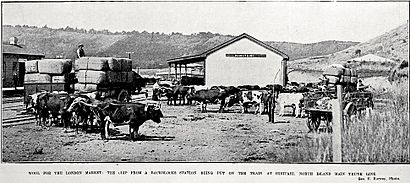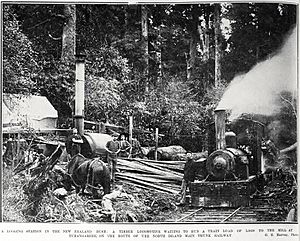Hīhītahi railway station facts for kids
Quick facts for kids
Hīhītahi railway station
|
|||||||||||
|---|---|---|---|---|---|---|---|---|---|---|---|

Hīhītahi station in 1911
|
|||||||||||
| Location | New Zealand | ||||||||||
| Coordinates | 39°34′14″S 175°42′21″E / 39.570497°S 175.705783°E | ||||||||||
| Elevation | 741 m (2,431 ft) | ||||||||||
| Line(s) | North Island Main Trunk | ||||||||||
| Distance | Wellington 270.79 km (168.26 mi) | ||||||||||
| History | |||||||||||
| Opened | 1 July 1908 | ||||||||||
| Closed | 1982 | ||||||||||
| Electrified | June 1988 | ||||||||||
| Services | |||||||||||
|
|||||||||||
Hīhītahi was a railway station in New Zealand. It was located on the North Island Main Trunk line, which is a very important railway line in the North Island. The station was in the Rangitikei District, within the Hautapu River valley.
Hīhītahi station served a small community that had a store and a school. It was about 12.55 kilometres (7.8 miles) south of Waiouru and 3.05 kilometres (1.9 miles) north of Turangarere. The station was at the top of a steep slope from Mataroa.
Contents
What Does Hīhītahi Mean?
The name Hīhītahi means "the first rays of the sun".
When the station first opened on 1 July 1908, it was called Tarangarere. Its name was changed to Turangaarere on 15 April 1909. Finally, on 21 August 1910, it became Hīhītahi.
There were also some extra tracks nearby called "crossing sidings". These allowed trains to pass each other. Until 1928, these sidings were known as Gardner & Sons Siding. Later, they took the old name of the station, Turangaarere, which then became Turangarere.
History of Hīhītahi Station
Work on the railway line near Hīhītahi began a long time ago. In 1887, a service road was built to help with the railway construction. By 1906, the Public Works Department had finished laying the rail and telegraph lines through Hīhītahi.
The New Zealand Railways (NZR) took over the station on 1 July 1908. It started as a "flag station," meaning trains would only stop if someone waved a flag or if passengers wanted to get off. This happened when the railway line was extended from Mataroa to Waiouru.
Plans for the station were made in 1903. A company was hired in 1907 to build it. By January 1908, the station was ready. It was a good size, with rooms for the stationmaster, luggage, and a waiting area. There was also a platform for people to get on and off trains.
The station also had a large shed for goods, a loading area for cattle, and water tanks. Houses for railway workers were built between 1904 and 1955. The station had a special track, called a crossing loop, where trains could wait. It was long enough for 54 wagons. A snowplough was also kept at the station to clear snow from the tracks.
Hīhītahi station stopped having passenger trains before 1972. It then closed completely for all railway traffic on 31 January 1982.
Railway Bridges Near Hīhītahi
Between Hīhītahi and Waiouru, the railway line crosses the Hautapu River using four bridges. These bridges were made from strong metal beams. Some parts were "latticed girders," which look like a criss-cross pattern, and others were "plate girders," which are solid metal plates.
Timber Tramways in the Area
Around Hīhītahi, there were at least three tramway networks. These were like small railways used to carry timber from the forests to sawmills and then to the main railway line.
- One company, Gibbs & Trevor, had a tramway that ran west from the station.
- Another company, George Gardner, had tramways to the northwest. They even had a special steam locomotive built in 1927.
- Other tramways were used by companies like W G Irvine and Quin Bros.
- In 1910, the Hawera Sash & Door Co Ltd had a 4-mile (6.4 km) tramway. It connected their logging area to their sawmill and the main railway. They used two different types of locomotives.
Most of these tramways were taken apart around 1934. This was because most of the native bush (forest) in the area had been cleared for timber.



